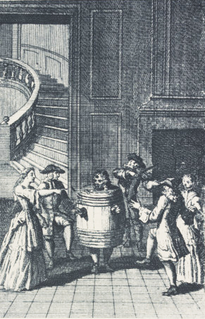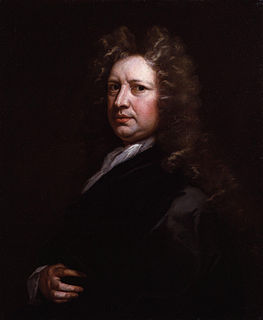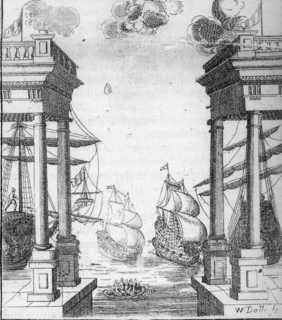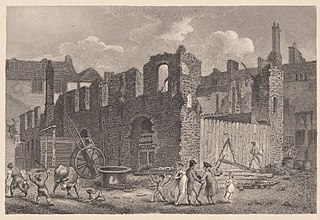History
The Duke's Company was one of the two theatre companies (the other being the King's Company) that were chartered by King Charles II at the start of the English Restoration era, when the London theatres re-opened after their eighteen-year closure (1642–60) during the English Civil War and the Interregnum.
The Duke's Company had the patronage of the King's younger brother Prince James, Duke of York and of Albany (later King James II & VII). It was managed by Sir William Davenant. The company started at the old Salisbury Court Theatre, and occasionally used the Cockpit in Drury Lane. After a year, the actors moved to a new theatre in Lincoln's Inn Fields, a building on Portugal Street that had previously been Lisle's Tennis Court (it opened on 18 June 1661). There they were joined by Thomas Betterton, who quickly became their star. In December 1660, the King granted the Duke's Company the exclusive rights to ten of Shakespeare's plays: Hamlet , Macbeth , King Lear , Romeo and Juliet , The Tempest , Twelfth Night , Much Ado About Nothing , Measure for Measure , Henry VIII , and Pericles, Prince of Tyre . [lower-alpha 1] In 1661, their first year at Lincoln's Inn Fields, the company revived Hamlet, in a production that employed the innovation of stage scenery. Samuel Pepys saw their production on 24 August; he described it as "done with scenes very well, but above all, Betterton did the Prince's part beyond imagination".
Davenant tried to make the most of the limited Shakespearean materials available to him. In 1662 he staged The Law Against Lovers , a heavily adapted version of Measure for Measure that blended in characters from Much Ado About Nothing. It was the earliest of the many Shakespearean adaptations produced during the Restoration era and the eighteenth century.
The company also acted some of the plays in the canon of John Fletcher and his collaborators. Yet the rival King's Company under Thomas Killigrew controlled more of the "Old Stock Plays", the traditional repertory of English Renaissance drama (Davenant even had to petition for the right to perform his own pre-1642 plays). The Duke's Company was driven to seek out new work by a new generation of writers, and to experiment with new forms and styles. The company performed the plays of Davenant, John Dryden, Thomas Otway, George Etheredge, Thomas Shadwell and others; it produced Aphra Behn's plays from 1670 to 1682. The company also acted many translations and adaptations of French and other foreign plays; their 1662 production of Sir Samuel Tuke's The Adventures of Five Hours , a version of Calderón's comedy Los Empeños de Seis Horas, ran for thirteen straight performances and was the first great hit of Restoration drama.
Like the King's Company, the Duke's pioneered the use of the first English actresses in the early 1660s. Their standout performer was Mary Saunderson, later Mrs. Betterton, who acted many of the lead female roles in Shakespeare's plays. Anne Gibbs (later married to Thomas Shadwell), Hester Davenport and Mary Lee also had noteworthy careers.
Samuel Pepys saw many of their productions, and recorded them in his Diary. King Charles witnessed many of their productions too; in a break with past practice, the King sometimes came to the theatre to see the plays, which in previous reigns had never happened. (Instead, the acting companies had always gone to Court to perform.) In its busiest seasons, the company staged fifty different plays in a year, ten of them new works.
After Davenant's death in April 1668, Betterton took command of the company, in collaboration with Davenant's widow Lady Mary Davenant. Their management team expanded its strategies to ensure success: the company engaged in three consecutive (and profitable) summer seasons in Oxford starting in 1669. On 9 November 1671 the company moved into a new theatre in Dorset Garden, sometimes called the Queen's Theatre, "the most elegant of all the Restoration playhouses...". The Duke's Company exploited the scenic capacities of the Dorset Garden Theatre to produce many of the Restoration spectaculars and the early operas and semi-operas that characterized the Restoration era. The most successful of the company's semi-operas was the Dryden/ Davenant adaptation of The Tempest, which premiered on 7 November 1667. From 1675 on, Elizabeth Barry acted with the Duke's Company and became recognized as one of the stars of the era.
Both the Duke's and King's Companies suffered poor attendance during the turmoil of the Popish Plot period, 1678–81. When the King's Company fell into difficulties due to mismanagement, the Duke's Company joined with them to form the United Company in 1682, under the Duke's Company's management. The United Company began performances in November of that year. The King's Company theatre, the Theatre Royal in Drury Lane, was used mainly for plays, while the Duke's Dorset Garden theatre was devoted to operas and spectaculars.
John Downes was the prompter of the Duke's Company from 1662 to 1706. In 1708 he published his Roscius Anglicanus, the "main source of information about the Restoration theatre" for later generations.
Company structure
Management
Sir William Davenant
Sir William Davenant was the first manager for the Duke's Company. Moreover, he was the patent holder and fundamentally the creator of the theatre group. After Killigrew had been granted his patent for the King's Company, Davenant drafted a document to give him and Killigrew duel monopoly over the theatre companies. Davenant could do this because he was rewarded with a warrant from Charles I during 1639 to build his own theatre, which whilst defunct still added gravitas to his claims. Furthermore, his masque work with Charles I, also being the writer for the two operas performed during the Puritan regime certainly cemented him as an accomplished and reliable manager to the second company. Thus the Duke's company was created.
Davenant, with a background in masque, grew to believe that spectacle was the way forward for British theatre. Mary Edmond comments that he "realised very early on that play goers would soon be demanding scenic theatres". Thus he went forward with creating theatre spaces that used changeable scenes, as well as always updating these scenes to make performances feel fresh and new for the audiences. During his time as manager he set the standard for the Duke's company. After being lumbered with only 23 plays in comparison to the King's 108, Davenant turned his company in the direction of new writing and adaptations of pre-restoration work that he did have. He worked with writers such as George Etheredge, John Dryden and Roger Boyle.
Not only did he attempt to keep the work performed for the Duke's men modern, he also had plans to keep the theatres as functional and of the highest quality. This new and exciting theatre manifested as Dorset Garden. Whilst this was not created until after his death, he managed to fund the project. He did this by selling 7 7/10ths of his shares to people at a price range of £600 - £800. Then sharers then managed to raise the rest of the substantial sum of £9000 which it is roughly considered to have cost.
Henry Harris and Thomas Betterton
The theatre house was built under the next set of managers for the Duke's company. This was the collaboration of Thomas Betterton and Henry Harris under the watch of Davenant's wife. Both Betterton and Harris were star players of Davenant. They continued the legacy of the Duke's company well. The theatre house that was erected during their time as managers was state of the art, boasting machinery, something that was no doubt inspired by European theatres. Furthermore, they continued to boast new writers including Aphra Behn, Thomas Otway and once again John Dryden. Unlike Davenant, neither wrote their own work. However, unlike the King's Company, the second managers wanted to make the transition as smooth as possible. Their decisions had "been reviewed by the board of sharing actors as well as by representatives of the Davenant family". Thus we see that despite having recognizable influence within the company, the duo didn't want to alienate or anyone involved in the company.
Ownership
As for who owned the company, it doesn't appear that there was one owner. Instead the companies were owned by shareholders who all had some say in the running of the company, and who helped with raising funds. Indeed, the main shareholder and patent holder should be considered the principal owner, which would therefore mean William Davenant would be the owner for the period of 1660–1668. Thereafter Lady Davenant would be considered the owner, with Betterton and Harris as the managers. William Van Lennep supports this assumption writing "The formal structure, then, of this type of arrangement consisted of a proprietor (the largest shareholder), who was the master of the company in both theatrical and financial affairs; a small number of sharing actors, who received a proportion of the profits after the gross receipts had provided for the major expenses; and a large number of actors on salary."
Joining the company
People joined the company by buying shares within the company, as "the companies were a business, and shares in them were sold to raise money needed to furnish theatres, hire personnel, and produce plays". Therefore, it is assumed that only those of a certain class could join the company.
Least influential member
In 1660, for the first time women were allowed to perform on the commercial stage. However, the significance of this at the time was evidently not as apparent. One can assume this because the records of this precise actress that performed is yet to be found; therefore suggesting that it was not recorded, undermining the influence of women performing in the theatre. An example of one of the women that was first to perform was Mrs. Eastland. Although her name appears on the prompter of Killigrew's original actresses, "her name appears on no dramatis personae until 1669 and she only ever played minor parts". In addition, she only appears on the cast list in 1669; nine years after the start of the company. In spite of the allowance of women in the theatre, it is evident that the patriarchal nature of the theatre was still very apparent. For men, the acting profession was a respected and successful career, however, "no woman with serious pretentions to respectability would countenance a stage career". But due to the nature and demands of being an actress; learning lines quickly, and needing to have a civilised etiquette meant that the company had to find women of a middle ground; this suggests the class differences, and the overall significance of men compared to women within the company.
Plays
The new theatre the Duke's Playhouse opened on 28 June 1661 in Dorset Gardens, with the spectacular The Siege of Rhodes. The new theatre encompassed new possibilities for the company to create rich and dramatic theatre. "A small stage and proscenium arch; the scenery consisted of wings fronting pairs of large painted flats which could be moved along grooves set in the floor and flies of the stage". This was the first public playhouse in England to use such innovation and so impacted the choice of play. The plays became spectacles; the Siege of Rhodes being a "magnificent production". Other productions such as Hamlet (1661), Love and Honour (1661) and The Tempest (1667) characterise the Company's restoration spectaculars and operas. Downes remarked that the adaptation of Love and Honour, originally from 1643, in 1661 was "Richly Cloth'd" with Betterton robed in fine garments and the set extraordinary.
Shakespeare
The Duke's Company were granted exclusive rights to ten Shakespearean plays; Hamlet, Macbeth, King Lear, Romeo and Juliet, The Tempest, Twelfth Night, Much Ado About Nothing, Measure for Measure, Henry VII and Pericles, Prince of Tyre. This, combined with the talented actors, such as Betterton, allowed the company to create adaptations of the Shakespeare's within the playhouse.
Davenant
William Davenant, as a manager and on good terms with the King, was able to use his patency and Betterton's talents to produce performances of his own plays. Killigrew and Davenant planned to put on tragedies, comedies, plays, operas, and all other similar entertainments, setting reasonable admission charges to meet "the great expences of scenes, musick and new decorations as have not bin formerly used".
Censorship
The King's theatre monopoly was controlled by the legislative power the Lord Chamberlain, who had the power to censor dramatic and printed work, having patents submit work 14 days before the performance. The Duke's Company found themselves subject to Chamberlain's legislation because of the comic performer and renowned improvisor, Edward Angel. During the run of Dryden and Davenant's The Tempest from 1667 to 1668, the Lord Chamberlain issued a warrant for the arrest of the comedian Edward Angel a member of the Dukes Company. Although the reasons behind the order remain unclear, one possible explanation is that Angel had caused offence with his talent for improvisation and unscripted political satire.
The licensing act even controlled the schedule and permitted attendees. For example, on 6 February 1720 he ordered Gay's new pastoral tragedy Dione be acted "immediately after Hughes"'s The Siege of Damascus .

"Restoration comedy" is English comedy written and performed in the Restoration period of 1660–1710. Comedy of manners is used as a synonym for this. After public stage performances were banned for 18 years by the Puritan regime, reopening of the theatres in 1660 marked a renaissance of English drama. Sexually explicit language was encouraged by King Charles II (1660–1685) personally and by the rakish style of his court. Historian George Norman Clark argues:
The best-known fact about the Restoration drama is that it is immoral. The dramatists did not criticize the accepted morality about gambling, drink, love, and pleasure generally, or try, like the dramatists of our own time, to work out their own view of character and conduct. What they did was, according to their respective inclinations, to mock at all restraints. Some were gross, others delicately improper.... The dramatists did not merely say anything they liked: they also intended to glory in it and to shock those who did not like it.

Sir William Davenant, also spelled D'Avenant, was an English poet and playwright. Along with Thomas Killigrew, Davenant was one of the rare figures in English Renaissance theatre whose career spanned both the Caroline and Restoration eras and who was active both before and after the English Civil War and during the Interregnum.

Thomas Patrick Betterton, the leading male actor and theatre manager during Restoration England, son of an under-cook to King Charles I, was born in London.

Thomas Killigrew was an English dramatist and theatre manager. He was a witty, dissolute figure at the court of King Charles II of England.

The Restoration spectacular, also known as a machine play, was a type of theatre prevalent in the late 17th-century Restoration period. Spectaculars were elaborately staged, comprising such setups as action, music, dance, moveable scenery, baroque illusionistic painting, costumes, trapdoor tricks, "flying" actors, and fireworks. Although they were popular with contemporary audiences, spectaculars have endured a bad reputation as a vulgar contrast to the witty Restoration drama.

Margaret Hughes, also Peg Hughes or Margaret Hewes, is often credited as the first professional actress on the English stage, as a result of her appearance on 8 December 1660. Hughes was the mistress of the English Civil War general Prince Rupert of the Rhine.
The patent theatres were the theatres that were licensed to perform "spoken drama" after the Restoration of Charles II as King of England, Scotland and Ireland in 1660. Other theatres were prohibited from performing such "serious" drama, but were permitted to show comedy, pantomime or melodrama. Drama was also interspersed with singing or dancing, to prevent the whole being too serious or dramatic.

The Dorset Garden Theatre in London, built in 1671, was in its early years also known as the Duke of York's Theatre, or the Duke's Theatre. In 1685, King Charles II died and his brother, the Duke of York, was crowned as James II. When the Duke became King, the theatre became the Queen's Theatre in 1685, referring to James' second wife, Mary of Modena. The name remained when William III and Mary II came to the throne in 1689.
The King's Company was one of two enterprises granted the rights to mount theatrical productions in London, after the London theatre closure had been lifted at the start of the English Restoration. It existed from 1660 to 1682, when it merged with the Duke's Company to form the United Company.

The Cockpit was a theatre in London, operating from 1616 to around 1665. It was the first theatre to be located near Drury Lane. After damage in 1617, it was named The Phoenix.

Lisle's Tennis Court was a building off Portugal Street in Lincoln's Inn Fields in London. Originally built as a real tennis court, it was used as a playhouse during two periods, 1661–1674 and 1695–1705. During the early period, the theatre was called Lincoln's Inn Fields Playhouse, also known as The Duke's Playhouse, The New Theatre or The Opera. The building was demolished and replaced by a purpose-built theatre for a third period, 1714–1728. The tennis court theatre was the first public playhouse in London to feature the moveable scenery that would become a standard feature of Restoration theatres.

Gibbon's Tennis Court was a building off Vere Street and Clare Market, near Lincoln's Inn Fields in London, England. Originally built as a real tennis court, it was used as a playhouse from 1660 to 1663, shortly after the English Restoration. As a theatre, it has been variously called the "Theatre Royal, Vere Street", the "Vere Street Theatre", or simply "The Theatre". It was the first permanent home for Thomas Killigrew's King's Company and was the stage for some of the earliest appearances by professional actresses.

Mary Saunderson (1637–1712), later known as Mary Saunderson Betterton after her marriage to Thomas Betterton, was an actress and singer in England during the 1660s and 1690s. She is considered one of the first English actresses.
George Jolly, or Joliffe was an actor, an early actor-manager and a theatre impresario of the middle seventeenth century. He was "an experienced, courageous, and obstinate actor-manager" who proved a persistent rival for the main theatrical figures of Restoration theatre, Sir William Davenant and Thomas Killigrew.
Nicholas Burt, or Birt or Burght among other variants, was a prominent English actor of the seventeenth century. In a long career, he was perhaps best known as the first actor to play the role of Othello in the Restoration era.
Anne Marshall, also Mrs. Anne Quin, was a leading English actress of the Restoration era, one of the first generation of women performers to appear on the public stage in England.

Love and Honour is a Restoration tragicomedy by English Renaissance theatre playwright Sir William Davenant which was produced at his playhouse Lisle's Tennis Court in Lincoln's Inn Fields in London for a 12 day run in October 1661 and which featured Thomas Betterton as Prince Alvaro and Hester Davenport as Evandra.
John Young was an English stage actor of the seventeenth century. He was active as a member of the Duke's Company during the Restoration Era, appearing at Lincoln's Inn Fields and then at the Dorset Garden Theatre when the company relocated. While not much is known about his background, he was repeatedly in debt during his acting career. In 1667 he stood in for Thomas Betterton after he fell ill during the run of Macbeth appearing as the title role. Samuel Pepys described him as "a bad actor at best".

Henry Harris was an English stage actor and theatre manager. Initially a painter he was a founder member of the new Duke's Company in 1660 following the Restoration which established itself at the old Salisbury Court Theatre before moving to the new Lincoln's Inn Fields Theatre shortly afterwards. Due to his background Harris may have been a set designer and painter during his early years with the company. However, by 1661 he was acting, and his first recorded role was in William Davenant's The Siege of Rhodes that summer. He quickly established himself as the second actor in the troupe after Thomas Betterton.
Marmaduke Watson was an English stage actor of the seventeenth century. Part of the King's Company based at the Theatre Royal, Drury Lane, he was one of the actors who sided with Charles Killigrew during a dispute in the company in 1677. In 1682 when the United Company was formed he left and went to Dublin to join the Smock Alley Theatre. He later returned to London where his final known performances were with Thomas Betterton's company at the Lincoln's Inn Fields Theatre.











